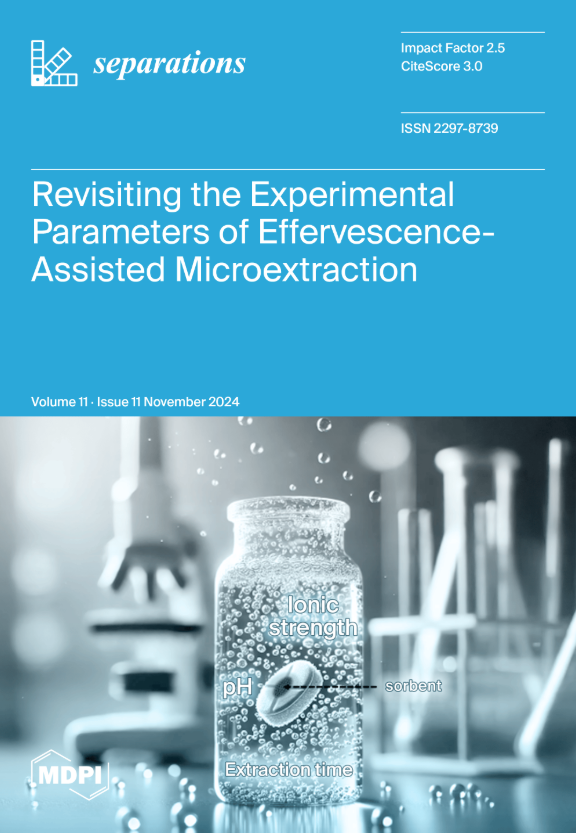Breaking the Equilibrium and Improving the Yield of Schiff Base Reactions by Pervaporation: Application to a Reaction Involving n-butylamine and Benzaldehyde
IF 2.7
4区 工程技术
Q3 CHEMISTRY, ANALYTICAL
引用次数: 0
Abstract
A comparative study of a Schiff base reaction involving benzaldehyde and n-butylamine was carried out to improve the yield of the resulting imine. This reaction was carried out at different temperatures without and with the elimination of the water produced during the process by the pervaporation (PV) technique using a typical cylindrical cell. To reach this goal, different dense membranes made of crosslinked poly(vinyl alcohol) with different oxalic acid (crosslinker) contents were prepared by the solvent casting method. Different parameters influencing the performance of the membrane in the separation process including swellability, diffusivity, crosslinking density, and thermal properties were investigated. The total and partial cumulative transmembranar fluxes as well as the separation factor were studied and the separation process was monitored by HPLC analysis. The n-butyl-1-phenylmethanimine produced was characterized by FTIR and 1HNMR analyses. The results obtained were a clear improvement in the yield of the reaction. For example, the yield obtained from the Schiff base reaction occurring without assistance by PV varied from 58 to 84 wt% when the temperature changed from 5 to 45 °C. On the other hand, when the PV process was used to eliminate water from this reaction mixture, the yield went from 90.4 to 98.6% by weight in this same temperature order. The cumulative total and partial fluxes significantly decreased with time. On the other hand, the separation factor reached a maximum at about one hour at 5, 15, and 45 °C. At 25 °C, the maximum total flux was reached at about 2 h of the PV process. The best selectivity of the PVA-0.5 membrane with regard to water was obtained at 15 °C. It was also revealed from the results obtained that the cumulative total and partial flux decreased rapidly with time and the separation factor reached a maximum at one hour into the PV process, in which 1.51 × 104 was reached at 15 °C, 6.25 × 103 and 3.50 × 103 at one hour of the separation process, and 10.23 × 103 at 25 °C at 2 h of the water removal by PV.通过渗透蒸发打破席夫碱反应的平衡并提高产率:正丁胺与苯甲醛反应的应用
对涉及苯甲醛和正丁胺的希夫碱反应进行了比较研究,以提高所得亚胺的产率。该反应是在不同温度下进行的,使用了一个典型的圆柱形电池,在不使用或使用渗透蒸发(PV)技术去除反应过程中产生的水的情况下进行的。为实现这一目标,采用溶剂浇铸法制备了由不同草酸(交联剂)含量的交联聚(乙烯醇)制成的不同致密膜。研究了影响膜在分离过程中性能的不同参数,包括溶胀性、扩散性、交联密度和热性能。研究了总和部分累积跨膜通量以及分离因子,并通过高效液相色谱分析对分离过程进行了监测。傅立叶变换红外光谱和 1HNMR 分析对生成的正丁基-1-苯基甲亚胺进行了表征。结果表明,反应的产率明显提高。例如,当温度从 5 ℃ 升至 45 ℃ 时,在没有 PV 辅助的情况下发生的希夫碱反应的产率从 58% 到 84% 不等。另一方面,当使用 PV 工艺去除该反应混合物中的水分时,在相同的温度顺序下,产率从 90.4% 增加到 98.6%(重量百分比)。随着时间的推移,累积总通量和部分通量显著下降。另一方面,在 5、15 和 45 °C 下,分离因数在约一小时后达到最大值。在 25 °C,PV 过程约 2 小时后总通量达到最大值。PVA-0.5 膜对水的最佳选择性是在 15 °C 时获得的。研究结果还显示,随着时间的推移,累积总通量和部分通量迅速下降,分离因子在 PV 过程开始一小时后达到最大值,其中在 15 °C 时达到 1.51 × 104,在分离过程一小时后达到 6.25 × 103 和 3.50 × 103,在 25 °C 时达到 10.23 × 103,PV 除水过程进行了 2 小时。
本文章由计算机程序翻译,如有差异,请以英文原文为准。
求助全文
约1分钟内获得全文
求助全文
来源期刊

Separations
Chemistry-Analytical Chemistry
CiteScore
3.00
自引率
15.40%
发文量
342
审稿时长
12 weeks
期刊介绍:
Separations (formerly Chromatography, ISSN 2227-9075, CODEN: CHROBV) provides an advanced forum for separation and purification science and technology in all areas of chemical, biological and physical science. It publishes reviews, regular research papers and communications. Our aim is to encourage scientists to publish their experimental and theoretical results in as much detail as possible. There is no restriction on the length of the papers. The full experimental details must be provided so that the results can be reproduced. There are, in addition, unique features of this journal:
Manuscripts regarding research proposals and research ideas will be particularly welcomed.
Electronic files and software regarding the full details of the calculation and experimental procedure, if unable to be published in a normal way, can be deposited as supplementary material.
Manuscripts concerning summaries and surveys on research cooperation and projects (that are funded by national governments) to give information for a broad field of users.
The scope of the journal includes but is not limited to:
Theory and methodology (theory of separation methods, sample preparation, instrumental and column developments, new separation methodologies, etc.)
Equipment and techniques, novel hyphenated analytical solutions (significantly extended by their combination with spectroscopic methods and in particular, mass spectrometry)
Novel analysis approaches and applications to solve analytical challenges which utilize chromatographic separations as a key step in the overall solution
Computational modelling of separations for the purpose of fundamental understanding and/or chromatographic optimization
 求助内容:
求助内容: 应助结果提醒方式:
应助结果提醒方式:


